

Tayrona National Park is a tropical paradise located on Colombia’s Caribbean coast. Chances are you’ve probably already seen photos of Tayrona National Park, particularly the famed Cabo San Juan beach. The park’s pristine beaches and lush tropical landscapes are an emblem of Colombia’s natural beauty.
In this Tayrona National Park travel guide I’ll share information that will help you plan your trip, whether you want to visit for just a day or stay overnight in the park. You’ll also hear the story of my night in a beachfront hammock gone wrong!
For more Colombia travel tips and destination guides, head to my Colombia page.
Tayrona National Park Information and History


Tayrona National Park (Spanish: Parque Tayrona) was founded in 1964 and is named after the indigenous Tairona people who originally inhabited the area. Tayrona National Park is a beloved Colombian destination thanks to breathtaking sandy beaches, coves lined with sea-smoothed boulders, and turquoise waters.
The area is home to diverse tropical flora and fauna, which visitors experience while walking the trails to the beaches. Tayrona National Park is a hotspot for eco-tourism and offers a variety of lodging options including tents, hammocks, and sustainable eco-hut resorts. The government manages the park in cooperation with local indigenous people to this day, with Tayrona National Park closed for short periods of time each year to promote its preservation.
Tayrona’s three annual closure dates have significance for the indigenous people:
February: Kugkui Shikasa, when the land renews itself.
June: Saka Juso, when the earth is menstruating.
October: Nabbatashi, when animals perform rituals to the earth.
My Tayrona National Park Trip Report
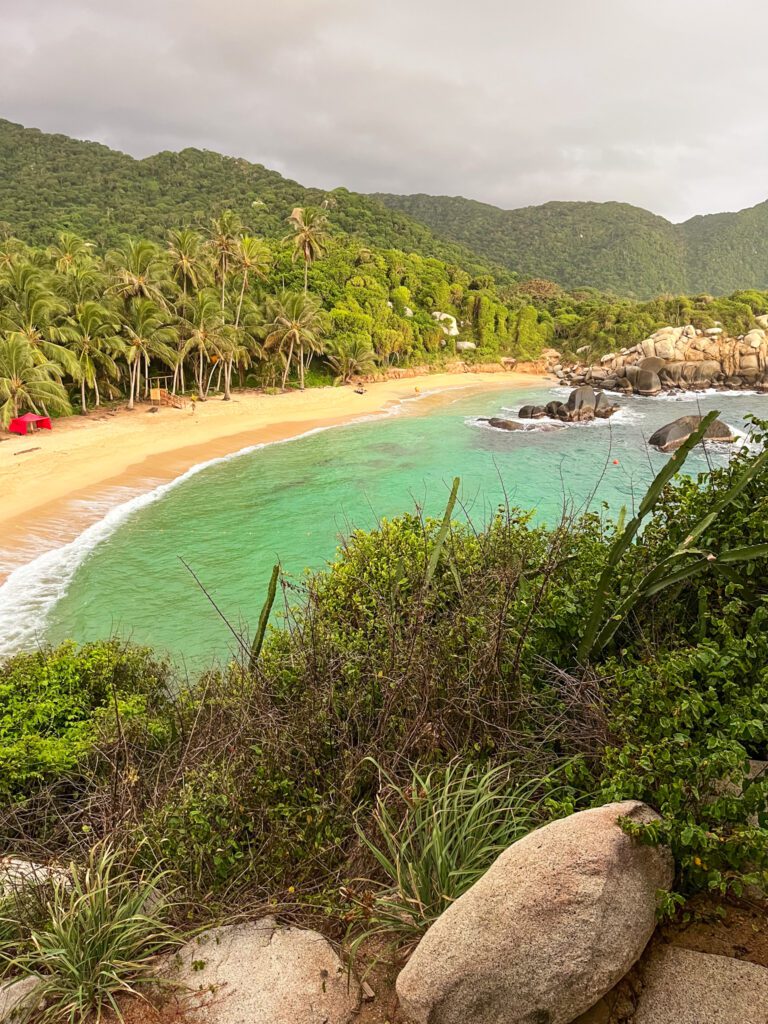

Getting to Tayrona
I took a local bus from my hostel in Santa Marta to Tayrona National Park. I planned to stay overnight in the park; sleeping in a beachfront hammock seemed to be a rite of passage for any backpacker traveling through Colombia. Although I’d never spent a night in a hammock before, I liked the idea of being rocked to sleep by the sea breeze and waking up to a sunrise above the beach. My backpack was heavy with camping essentials as well as food and water. I’d heard that vendors in the park were overpriced, and I was determined not to exceed my daily budget.
Getting to Cabo San Juan
Upon arrival at the main Tayrona National Park entrance (Zaino), I paid my entrance fees and reserved a hammock for the night. I then caught the shuttle to the trailhead at Cañaveral. The Tayrona National Park hike passes by picturesque beaches and stretches of jungle teeming with monkeys and coconut groves. After about 2 hours, I reached Cabo San Juan. It was still early in the day so I continued onward to the nearby Playa Nudista. The beach was pristine and, surprisingly, lacked any nudists.
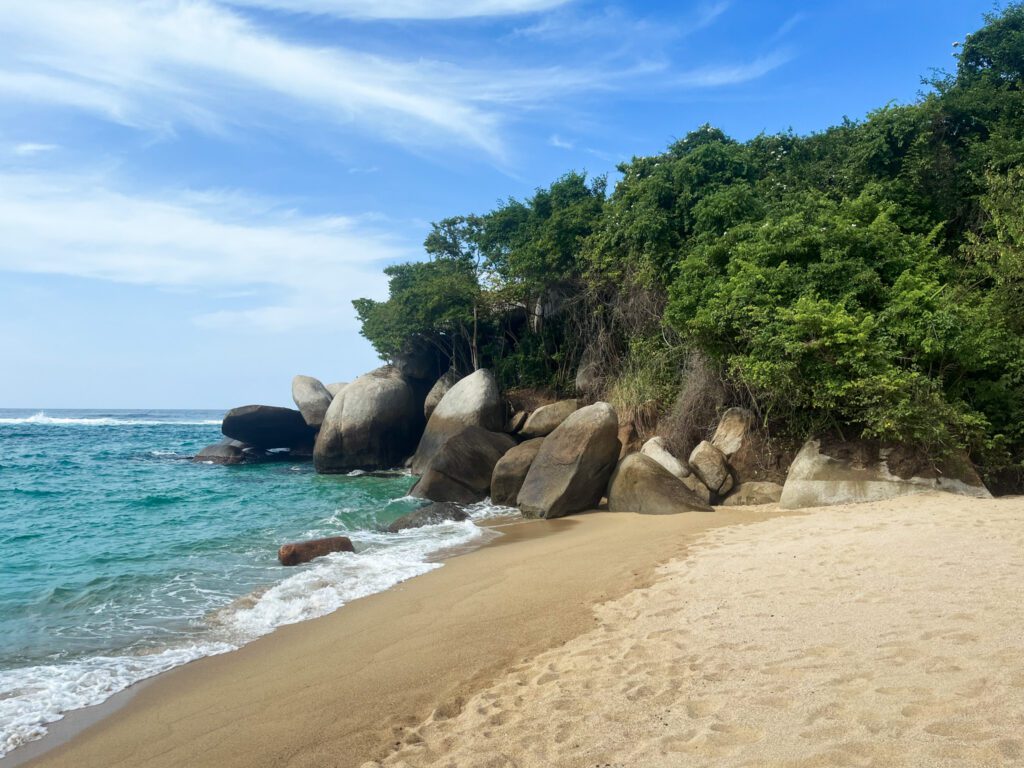

From Playa Nudista I made a tiring trek up and down a hill to reach Playa de las Bravas. The expansive beach, spacious grassy campground, and lack of crowds made me wonder if I should have stayed there instead of the circus-like Cabo San Juan.
It was getting late, so I hiked 3.9 mi (6.3 km) back to Cabo San Juan. I checked into my assigned hammock, which was perched on a scenic rock overlooking both coves of the beach. The hammocks appeared to be crusted with a layer of dried sweat (I tried to reassure myself that this might also be seawater). I already wished I had booked a tent instead, as they came with fresh bedsheets and looked more hygienic.
Camping in Tayrona National Park
By late afternoon day tourists had left and the beach felt more calm. I waited in the long line for a shower, then walked around the campground barefoot for the rest of the evening. I had brought just one pair of shoes, which was now sandy and muddy. For dinner I went to the only restaurant at the campground and saved half of the food in a tupperware box for breakfast the next day.


I’m not sure why I thought it would be a good idea to sleep in a hammock for the first time in a remote national park, but needless to say I didn’t sleep well. The wind picked up during the night, transforming the tropical air into a frigid breeze. The forceful gusts painfully slapped the empty hammocks next to me into my body. It also blew my drying clothes off the edge of the shelter.
I panicked at the thought of losing my only set of clothes to the sea and found myself scrambling down the steep, rocky slope in the middle of the night to recover them. The other hammock campers were doing the same throughout the night, waking everyone with their bright headlamps. Although I envisioned being serenaded by gentle ocean waves, instead the night consisted of howling wind and the rattling of stray bottles and trash on the floor.
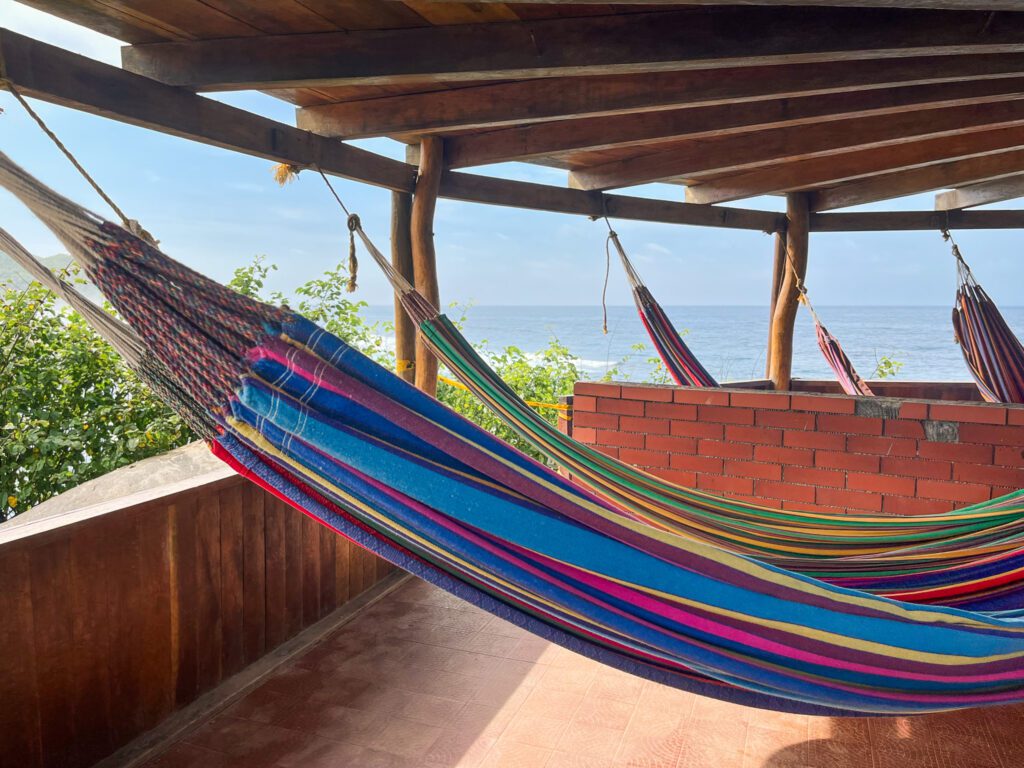

Sunrise
After intermittent and restless sleep, I woke up to the sound of people rustling about. I briefly panicked, thinking I had missed the sunrise and endured a night in the hammock for nothing. Fortunately there were still 15 minutes to spare. The sunrise turned out to be beautiful, but I vowed that if I were to do this again, I would get a good night’s sleep in a tent and walk over to the beach for sunrise.
After sunrise I hiked back to the park entrance, exploring several beaches I didn’t get the chance to visit the day before. I tried unsuccessfully to nap on Piscina beach, where even the lifeguard on duty was dozing off on a mattress precariously perched on the slanted roof of his shack. I then continued along Arrecifes beach. Arrecifes was not safe for swimming but had a beautiful river and freshwater lagoon. Eventually I returned to the park entrance and boarded the bus back to Santa Marta, looking forward to sleeping in an actual bed.
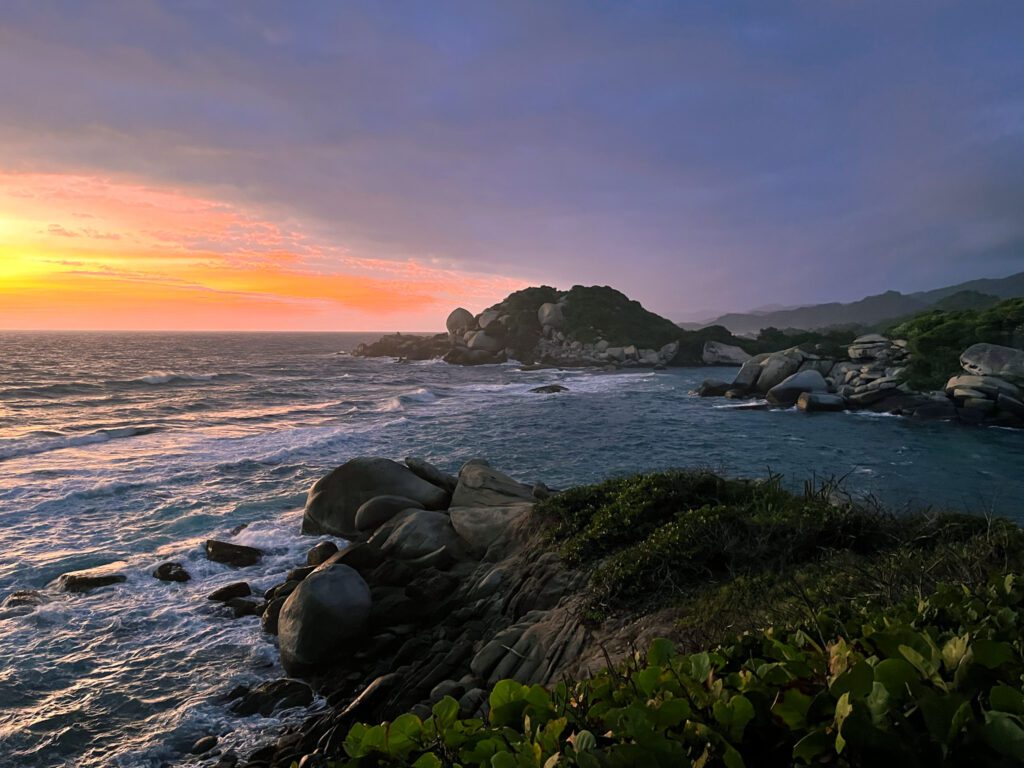

Tayrona National Park Trip Planning Information
What to Do in Tayrona National Park
The best thing to do in Tayrona National Park is to hike to the beaches. The trails to the beaches are easy to follow and no guide is required.
All of the beaches are very picturesque, but many are not safe to swim in due to strong currents and riptides. If you’d like to swim, take this into account as you plan your visit! The must-see beach in Tayrona National Park is Cabo San Juan, which is safe for swimming and easily accessed from the park’s main entrance (Zaino).
Tayrona National Park Map
Tayrona Hiking Trail Map
Most visitors spend their time in Tayrona National Park hiking from Cañaveral to Cabo San Juan. This hike is 7.5 mi (12 km) round trip, mostly flat, and can be completed in a day. Below I’ve listed the main attractions along this hike, in order of distance from the park entrance.
Cañaveral
Cañaveral is the starting point of the majority of the trails within Parque Tayrona. It’s best to take a shuttle from the Zaino park entrance to Cañaveral for 5,000 COP (1.27 USD) to skip an hour-long walk along the road.
There is food available at Cañaveral, as well as accommodation in the form of camping and cabins. It’s not safe to swim at Cañaveral beach, but you can swim in the adjacent Piscinita cove.
Playa Arrecifes
Arrecifes beach is a 2 mi (3.2 km) walk from Cañaveral. Arrecifes has food available for sale, as well as hammocks, tents, and cabins for rent. The beach is very picturesque, but it’s not safe to swim in.
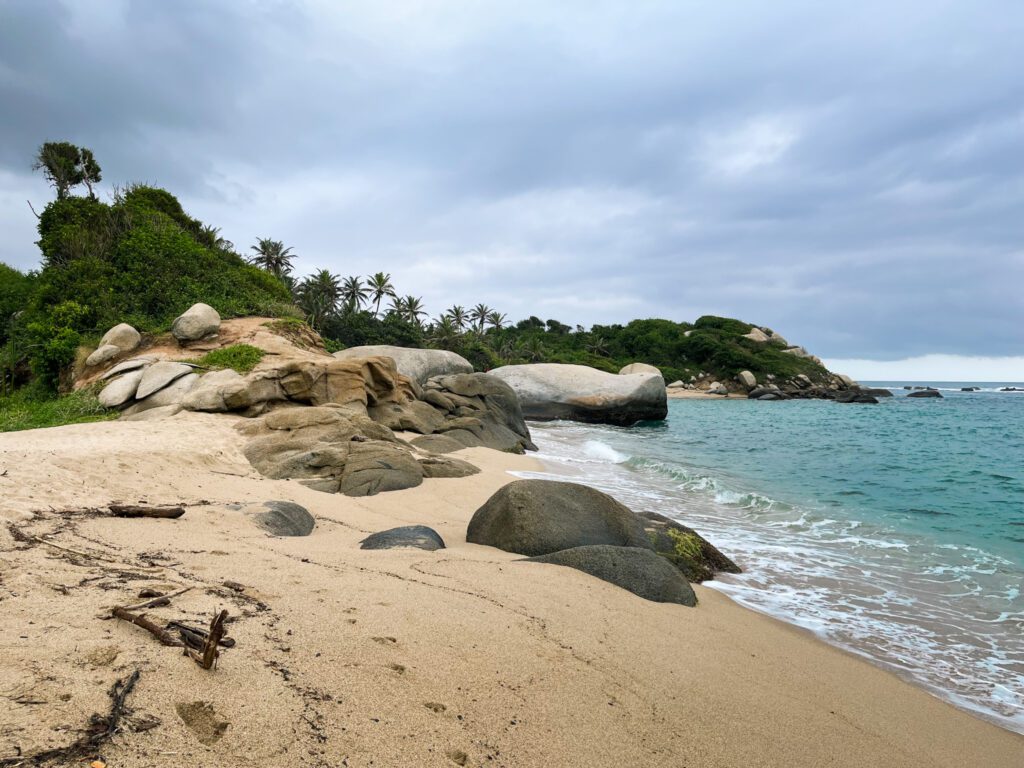

Playa Piscina
Piscina beach is 1 mi (1.6 km) from Arrecifes. It’s safe to swim there, but there is no food or accommodation available.
Cabo San Juan
Cabo San Juan is 0.8 mi (1.3 km) from Piscina and the most famous beach in Tayrona National Park. It’s safe to swim there, and there are hammocks and tents available for rent. There’s also a restaurant and snack vendors.
Playa Nudista
Most people end their hike at Cabo San Juan, but if you’d like to continue, you can visit additional quieter beaches. The first beach after Cabo San Juan is Playa Nudista, a 0.7 mi (1.1 km) walk away. Depending on conditions it may or may not be safe for swimming. There’s no food or accommodation at Playa Nudista. Also, contrary to its name, I didn’t see any nudists there during my visit!
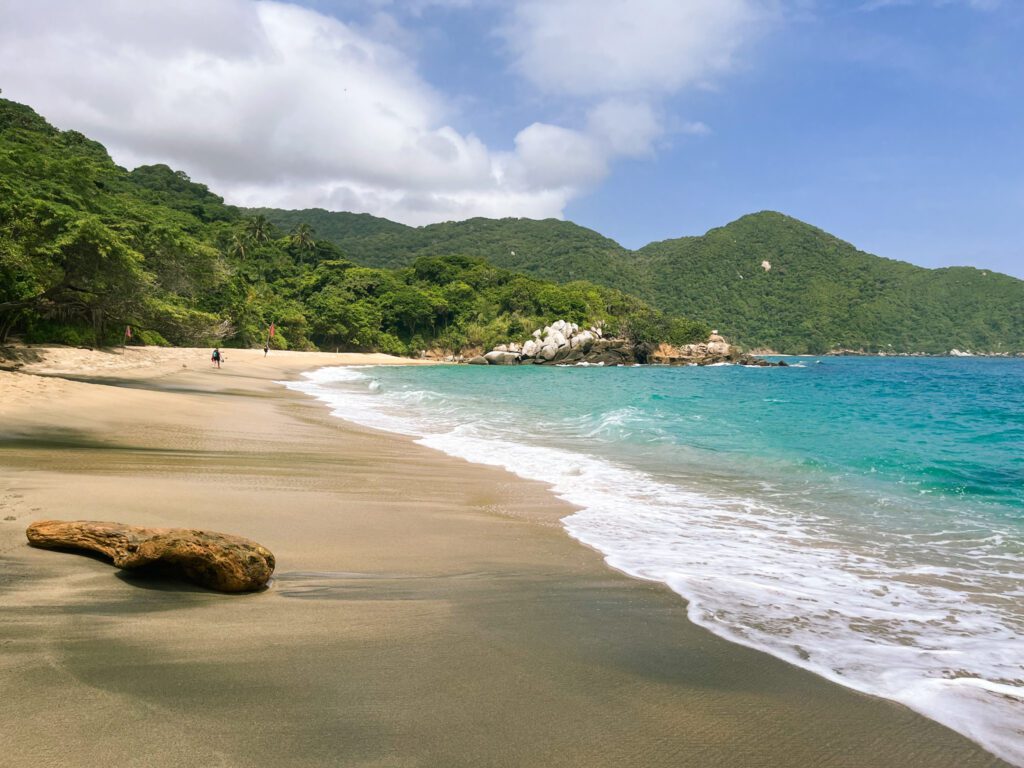

Playa Brava
Playa Brava is a 3.9 mi (6.3 km) hike from Cabo San Juan. The hike to get there requires a strenuous ascent and descent, so make sure you’re up for the challenge and have proper shoes. Playa Brava is not safe for swimming, but food is available there and they have many hammocks and cabins for rent.
Sailing
If you’d rather not hike or just don’t want to deal with the logistics of getting to and from Tayrona National Park from Santa Marta, consider a sailing tour! These tours will take you directly from the city of Santa Marta to the beaches of Tayrona National Park, and you’ll get views of the coastline from the water. I recommend this sailing tour as well as this one.
Horseback Riding
Horseback riding tours in Tayrona National Park are available within the park, or you can reserve in advance. This is another great option to visit the beaches if you don’t want to hike.
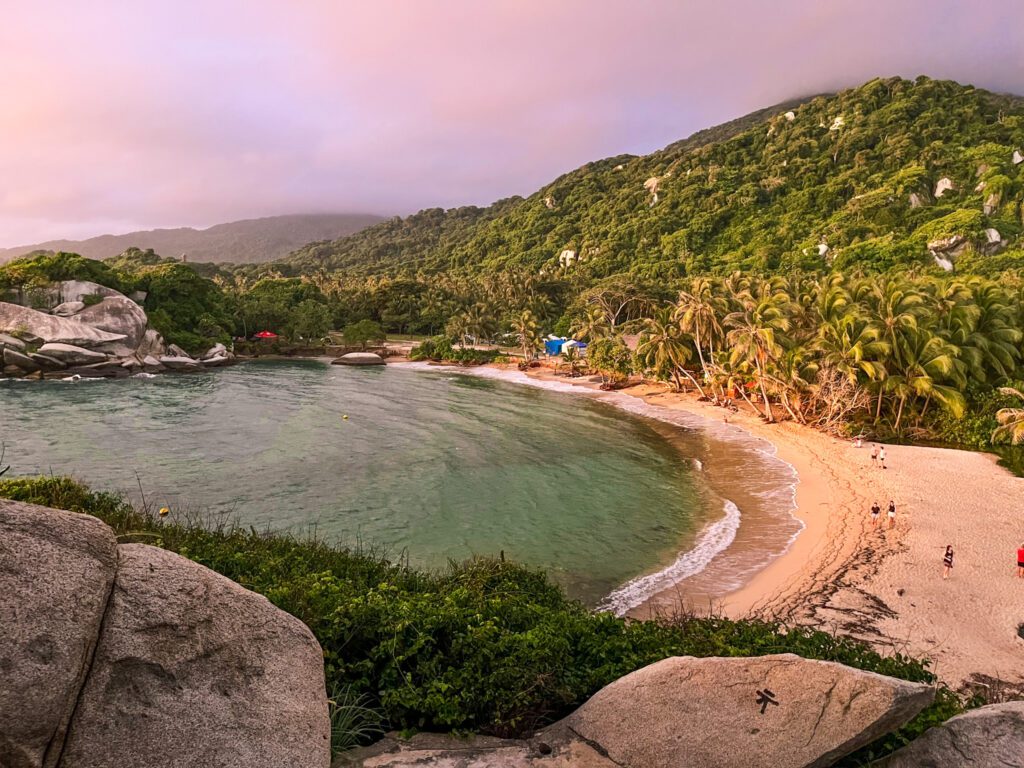

How Long to Stay in Tayrona National Park
The highlight of a visit to Tayrona National Park is Cabo San Juan beach, which can be visited in a full day from Santa Marta. However, to explore more of the park at a leisurely pace, spend a night or two in a cabin, tent, or hammock on one of the beaches. Staying overnight will also allow you to enjoy quiet moments in the morning and late afternoon without the crowds of day tourists.
Tayrona National Park Weather and When to Go
The dry season in Tayrona National Park is December to April and, to a lesser extent, June to August. This region is hot and humid throughout the year, with warm nights. If you plan on sleeping in a beachfront hammock like I did, prepare for potentially chilly nights due to wind.
Avoid visiting the park on weekends and holidays, since it will be filled with local tourists. December and January also tend to bring crowds to the area.
Keep in mind that Tayrona National Park is closed during certain times of the year. In past years Tayrona National Park was closed for 15 days in February, June, and October.
Arrive at the park slightly before it opens at 7 AM to avoid long lines at the entrance. If you’d like to stay in the park overnight, arriving early will also ensure you can reserve a tent or hammock (first-come-first-serve system). Tayrona National Park entrance is open until 12 PM, and visitors who are not staying in the park overnight must start making their way out between 2 and 5 PM.
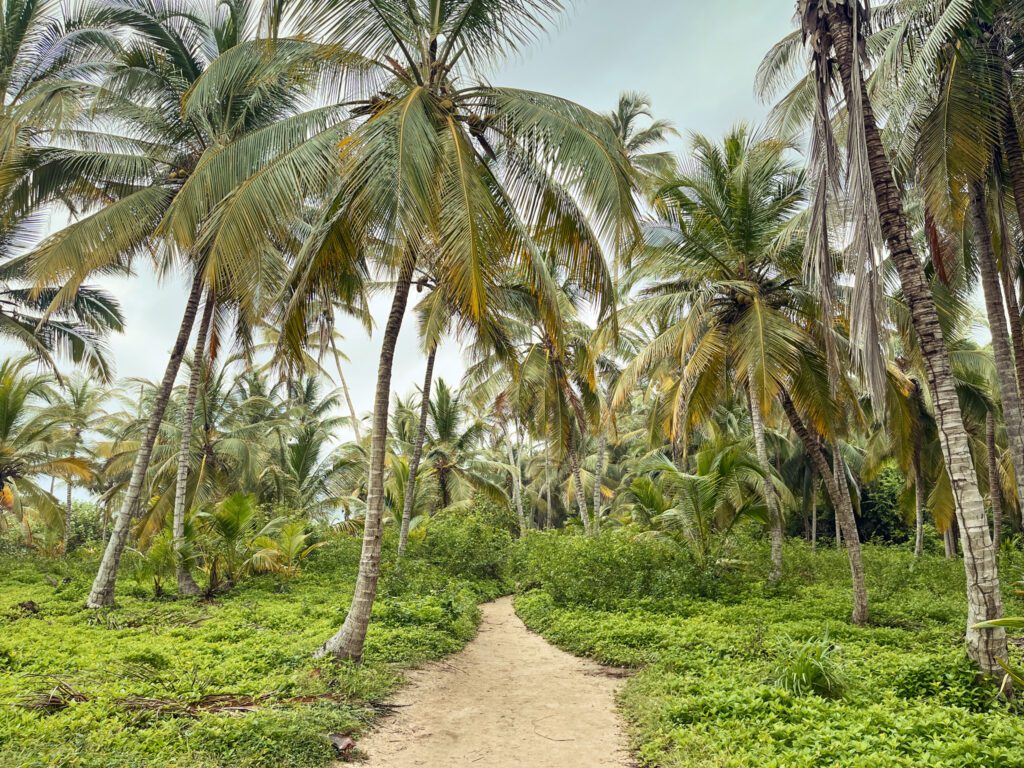

Tayrona National Park Hotels and Accommodation
It’s possible to visit Tayrona National Park as a day trip from Santa Marta. However, staying at least one night in the park will allow you more time to explore. You’ll also get to enjoy the beaches in the mornings and evenings when the crowds of day trippers are not there.
Accommodation within Tayrona National Park
The park offers hammock or tent rental as well as cabins. Tents and hammocks are reserved day-of, either at the Zaino entrance or at the campgrounds themselves. Cabins can be reserved in advance online.
Tents are furnished with a mattress, bedsheets, and pillows, and all of the tents I saw looked very hygienic. No wild camping is permitted in Tayrona National Park, but you can bring your own tent and set it up in established areas for a cheaper price.
Accommodation prices may vary depending on the season and exact place you want to stay in. A rough estimate would be a 2-person tent for 140,000 COP (35.70 USD), and a hammock for 50,000 COP (12.75 USD).
Accommodation is available in the following places:
Cabo San Juan: the most scenic and popular place to stay. Choose from tents or hammocks.
Playa Arrecife: you can book a hammock or tent at Camping Tequendama Playa Arrecifes. You can also book cabins here.
Playa Cañaveral: there is camping available here, but for a more comfortable experience stay in the luxurious Ecohabs cabins.
Playa Brava: there are hammocks here, as well as reservable cabins.
Castilletes: Castilletes is between the Zaino entrance and where the hiking trails start at Cañaveral. You can reserve rooms, hammocks, or tents at Castilletes here.


Accommodation near Tayrona National Park
If you’re not staying within the park, it’s a good idea to stay either in Santa Marta or right next to the park entrance. These are the places I’d recommend that are near the park entrance:
Budget: Hostal Recuerdos del Tayrona
Mid-range: Magic Green, Hostal Zirumake
Luxury: Ecohabs Bamboo, Ecohotel Yachay
Where to Eat and Drink
To stay safe, stick to filtered or bottled water, which you can bring with you or purchase in the park.
There are only a few places to buy food and drinks in Tayrona National Park. On top of this, items sold by vendors in the park are expensive due to the park’s remote location. If you don’t want to overpay, bring as much food and water as you can in your backpack! Within the park, food is available at Playa Cañaveral, Playa Arrecife, Cabo San Juan, and Playa Brava.
The area just outside of the Zaino park entrance is full of street food and vendors selling affordable snacks.
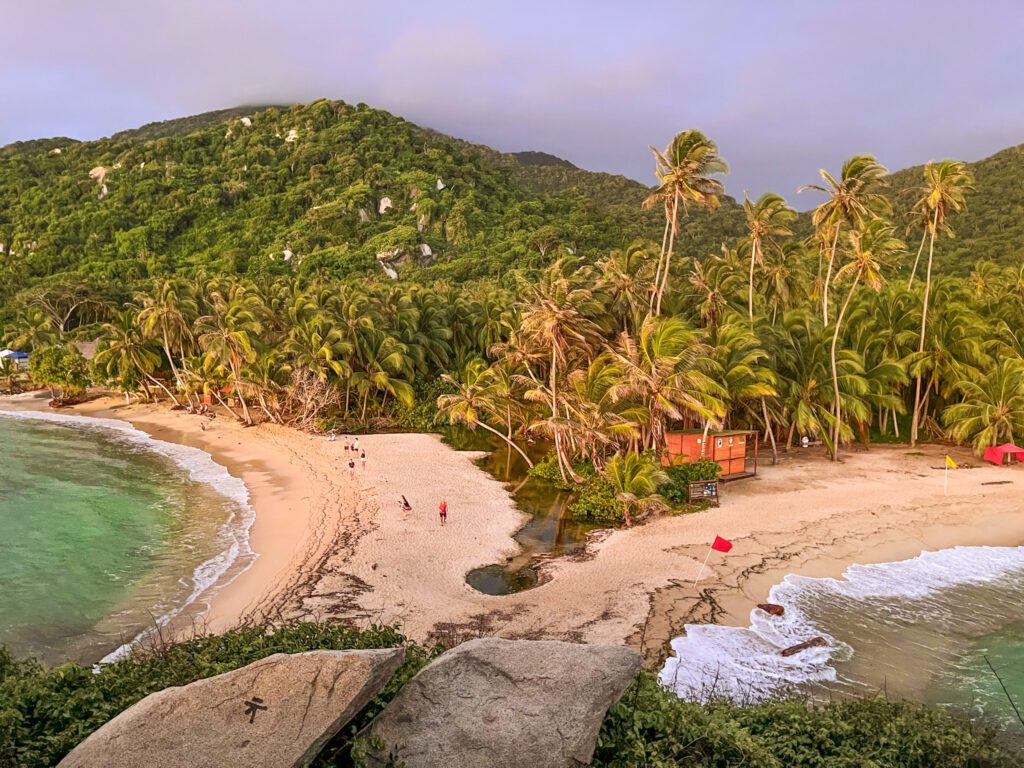

Is Tayrona National Park Safe?
The park is popular with both local and international tourists and is very safe to visit.
To stay safe, don’t swim in beaches that are marked dangerous for swimming due to strong currents. Also, if you’re traveling alone, keep an eye on your valuables at the beach. Better yet, get a dry bag to keep your valuables with you when you go into the water.
Check out my Colombia safety guide for more tips, and make sure you have travel insurance.
Tayrona National Park Tickets and Fees
Tayrona National Park entrance fees for foreigners are 62,000 COP (15.80 USD) in low season and 73,500 COP (18.75 USD) in high season.
To enter the park it’s also required to purchase their medical insurance (even if you have your own) for 6,000 COP (1.53 USD).
There aren’t any ATMs in Tayrona National Park and many vendors accept only cash, so come prepared. Bring enough cash for entrance fees, food and drinks, your accommodation (if applicable), and transportation to and from the park.
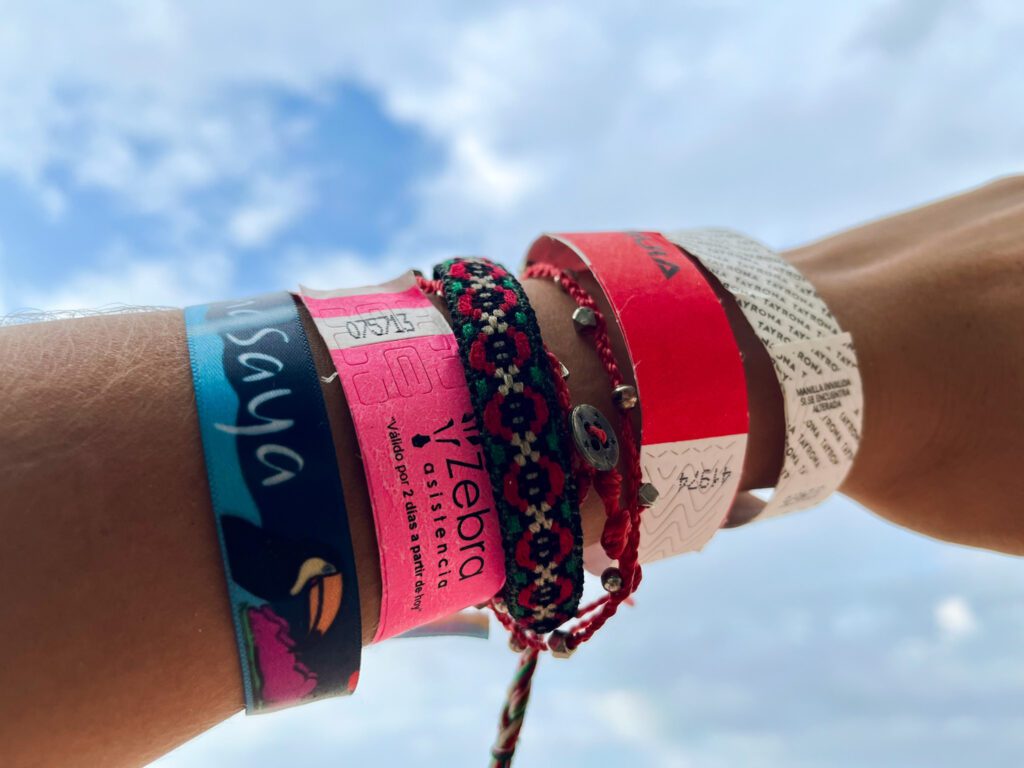

What to Bring to Tayrona National Park
If you’ll be hiking within the park, check out my day hiking checklist. For a full list of what to bring, refer to my Colombia packing list. I would stress the following:
- Downloaded maps of Tayrona Park on Google Maps or MapsME. There is no phone service or WiFi in the park.
- The yellow fever vaccine is recommended for visitors to Tayrona National Park, and you can get it for free at Bogotá airport.
- Good quality backpack
- Good walking shoes (Women’s, Men’s). While I wouldn’t recommend flip flops, I saw a lot of people walking in them.
- Sunscreen
- Hat
- Mosquito spray
- Lightweight towel
- Water, snacks, picnic lunch
- If you’ll be staying in the park overnight, bring a small backpack with overnight necessities (toiletries, towel, change of clothes, etc.). Bring toilet paper for the restrooms. Leave your main bag at your accommodation in Santa Marta.
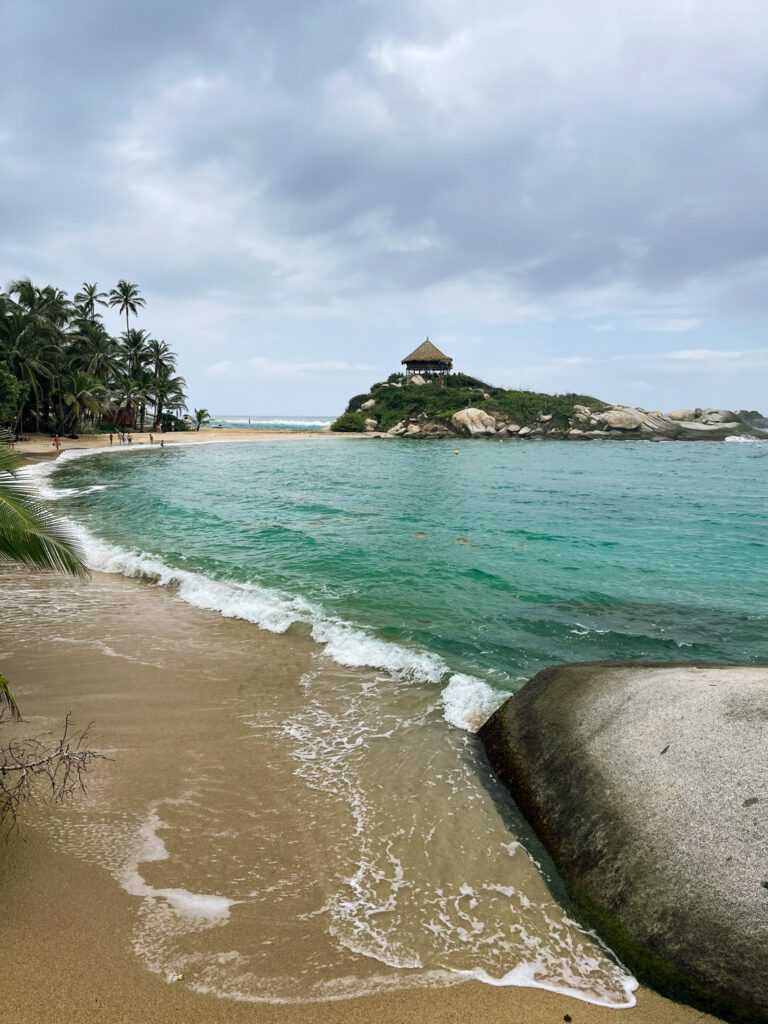

How to Get to Tayrona National Park
If you don’t want to deal with the logistics of getting to the park yourself, book a Tayrona National Park tour that will take care of that for you.
Tayrona National Park is most easily accessed from Santa Marta, Colombia. There are 2 park entrances: Calabazo and Zaino. Zaino is the main entrance, and it’s closer to the majority of the beaches. Calabazo is much less crowded, but it’s a longer walk (~5-6 hours) to get to Cabo San Juan from there. If you enter the park from Calabazo, you’ll need to spend at least one night in the park to visit all of the main sights. To get to either of the entrances, there are multiple options:
By Private Transportation
Check with your accommodation; it’s possible that they offer shuttle services to and from the park. You could also take a taxi. Rideshare apps don’t always work in the Santa Marta area.
By Bus
Local buses running from Santa Marta to Riohacha and Palomino will stop at Tayrona.
If you’re staying in the center of Santa Marta, you can catch the bus to Tayrona from the station next to the Mercado Publico (at the corner of Calle 11 and Carrera 9). The bus starts at 6 AM and runs frequently.
If you’re staying near Santa Marta’s bus station, you can catch the bus from there. If you’re staying at Dreamer hostel, catch the bus along Calle 39.The bus starts at 6 AM and runs frequently.
The bus is ~9,000 COP (2.30 USD) and takes 45 min to get to Tayrona’s main entrance (Zaino). To get to the Calabazo entrance, take the same bus but get off earlier.
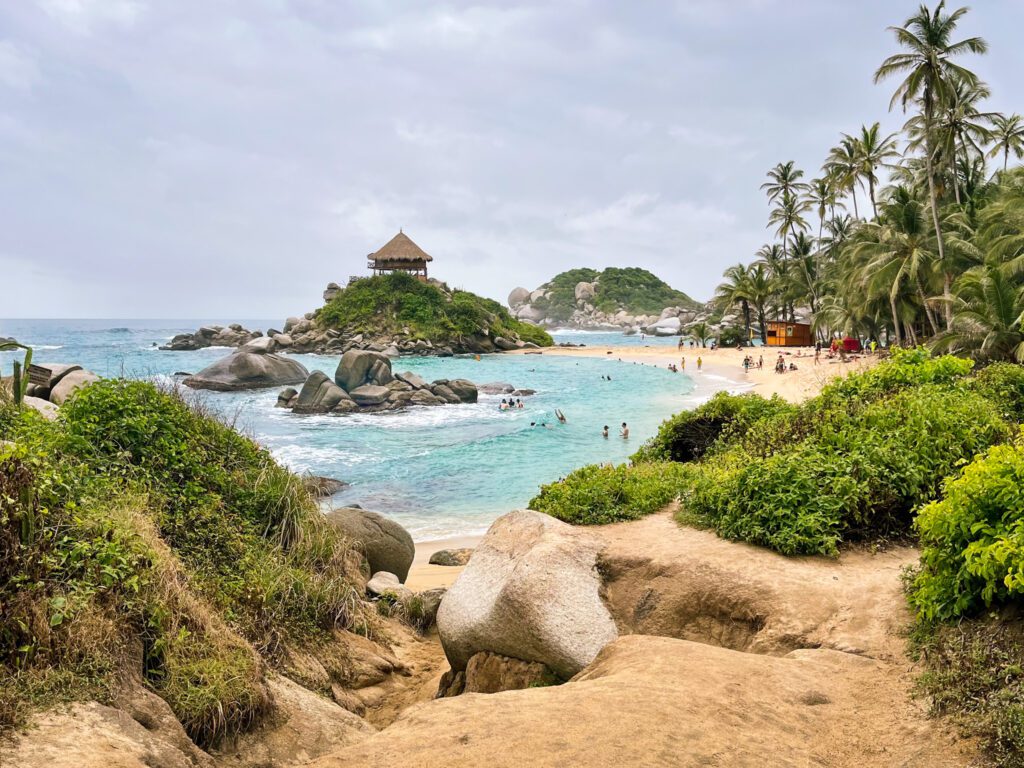

By Boat
Boats to Tayrona National Park leave from Taganga (a 10 min drive from Santa Marta) and take you directly to Cabo San Juan beach in 45 min. The boat is 80,000 – 100,000 COP (20.40 – 25.50 USD), departing in the morning and returning in the evening.
It’s also possible to buy one-way boat tickets. For example, you can hike from the park entrance to Cabo San Juan, then at the beach buy a boat ticket to take you back to Taganga.
How to Get Around Tayrona Park
Most visitors walk the trails between the beaches. However if you don’t feel like hiking, sailing and horseback riding are good alternatives. You can also hire horses to carry your bags for you if you’re staying overnight.
Where to Go Next
- Santa Marta
- Minca
- Palomino


Thanks for reading, and I hope this guide to Tayrona National Park helps you prepare for your trip! Would you camp overnight in a hammock by the beach? Let me know in the comments.
For more Colombia travel tips and destination guides, head to my Colombia page.
Confirm all logistical and safety information before your trip. Also If you buy through links on this site, I may earn an affiliate commission. Thanks for supporting me in creating free content for you to enjoy!
Save this post for later and share on Pinterest!
TRAVEL RESOURCES
Head to my Travel Resources Page for more recommendations.
Packing list. See my recommendations for packing a carry-on for long-term or multi-season travel.
Booking.com. This is my go-to platform for booking accommodation since it consistently gives me competitive prices and additional discounts based on usage.
SafetyWing. The most affordable travel insurance I’ve found that also offers excellent coverage.
Viator and Get Your Guide. Offer extensive tour options for both day trips and multi-day excursions.
BusBud. A great platform to search for bus routes in more than 80 countries and buy tickets online.
LifeStraw. This easy-to-use water filter guarantees that you always have access to clean drinking water.
Travel Credit Card. Earn substantial points for travel-related expenses and a very generous bonus when opening an account.
Comments
-
If you stay overnight, you have to pay the entry fee only once for the entire stay?
-
yes, that’s correct!
-




Hi, I’m Kristina! I’m a solo female traveler sharing my personal experiences around the world. Authentic travel is important to me; in my destination guides I emphasize not just the most spectacular sights but also the local stories and history.
Other things I’m passionate about are discovering hidden gems, budget-friendly travel, and hiking and backpacking. My goal is to show you how to seek adventurous experiences for yourself!



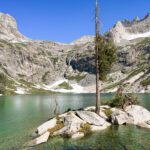
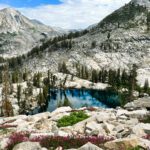

Leave a Comment